A City Story, A River Tide Enters the First Scenic Spot for Tide Viewing in Qiantang - Yanguan Town, Haining
order
When I was a child, my mother told me that there was a Qiantang River on the land of Wuyue.
When I was in school, my teacher told me that the most spectacular sight in Chinese textbooks is undoubtedly the Qiantang during the rising tide in classical Chinese.
When I grew up, my friend told me that the turbulent and majestic world was not far from me.
This place is Haining, a cultural land on the edge of Hangzhou, and the hometown of Xu Zhimo and Jin Yong.
The 15th day of the eighth lunar month, around the Mid Autumn Festival, is the season for observing the tides in Qiantang every year.
I came from Hangzhou to Yanguan Ancient Town in Haining City, waiting for a raging storm like the roar of thousands of troops and horses.
Yanguan Town, under the jurisdiction of Haining City, Zhejiang Province, is located on the north bank of the Qiantang River, facing Xiaoshan across the river. It is a famous historical and cultural town in China. The name "Salt Officer" originated in the Western Han Dynasty, and was named after Liu Bi, the King of Wu, who boiled the sea to make salt. He established a Salt Officer here and has a history of more than 2200 years.
Arriving at Kaiyuan Temple in Haining Salt Official Ancient City
The hotel chosen this time is a light luxury ancient mansion - the newly opened Haining Salt Official Ancient City Kaiyuan Temple, a cultural themed hotel under Kaiyuan Group.
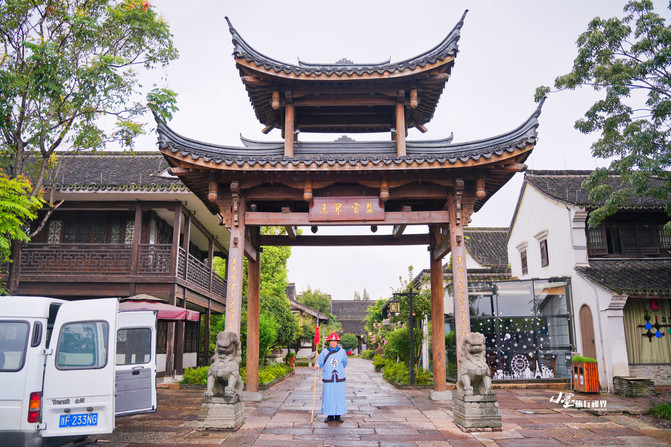
The gatekeeper and staff were all dressed in the attire of Qing Dynasty soldiers, with a strange sense of time travel in a daze.


A city story, a river tide.
The hotel is located in Yanguan Ancient Town, a historic and cultural town in Haining City, the throat of the Qiantang River. As the mouth of the Qiantang River, it has been an important material distribution center and commercial center since ancient times.

For thousands of years, the ancient city has preserved many famous people's former residences and traditional customs. Among them, Haining shadow puppetry is a typical representative of Jiangnan shadow puppetry, with a history of over a thousand years.

After checking in at the front desk, the waiter drove a small car around several courtyards to deliver me and my luggage to the room.

During the Jiangshan period, talented people emerged. In ancient times, the Salt Officials Ancient Town was renowned for its outstanding people and outstanding land. The Chen family alone witnessed the miracle of having "one family, three people, four attic elders, six departments, five people, and seven Shangshu". Over the course of more than 300 years, there were a total of 31 successful candidates and more than 100 successful candidates, becoming a prominent family in the Jiangnan region that passed down poetry and literature during the Ming and Qing dynasties.

I have always been fond of ancient cultural hotels with history, connotation, and charm, from the Kaiyuan Manju in Wuzhen and Yuyao to the Kaiyuan Guantang in Shaoxing Dayu and Ningbo Seventeen Rooms. In recent years, I have also stayed in many hotels under the Kaiyuan brand.
The quaint courtyard perfectly interprets the gentleness of Jiangnan.

The Kaiyuan Temple in Haining is located in the core area of Yanguan Ancient Town, surrounding the core part of the old street of the ancient city, Chen Ge's old house, and the surrounding traditional residences of all sizes. It preserves the original historical appearance and natural ecological environment, deeply explores the local traditional folk culture, and presents the pulse and charm of Jiangnan water towns and gardens to every dusty traveler.

The interior decoration of the hotel rooms is quite ancient and charming,
The Chinese retro style fills every small detail here.


Exquisite toiletries,
It looks like the makeup box used by the ladies of ancient times in movies.
emmmm, When the window trims the temples, is the mirror sticker yellow?
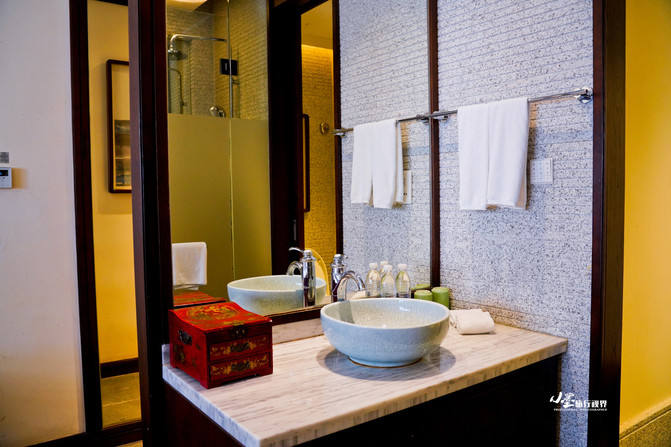
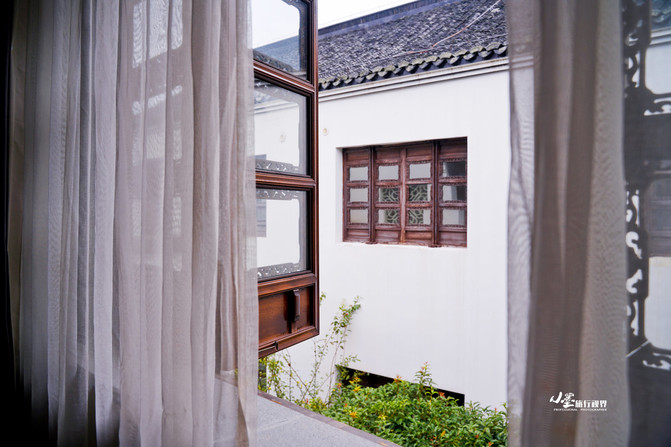
Pushing open the window, one can see the ancient Jiangnan courtyard in front of them. The spatial layout is the structure of the old official residence in Yanguan Ancient Town, with a three in one corridor architectural form, giving a sense of looking back on the vicissitudes of time and surprise.

Living in the city, either working nine to five, sleeping, opening eyes, eating, going to work, day after day, year after year. Life is as plain and unremarkable as a stagnant pool, and one can see at a glance what they will look like decades later. Do you still remember your past goals and dreams when you were young?
Either busy from sunrise to starry sky, endless work, endless clients, and overtime until early morning hours are commonplace. Are you, exhausted both physically and mentally, still in the mood on your way to work, looking up to admire the brilliant starry sky?
Yes, in a city with bright lights, it's difficult to see the starry sky.

Here, this cultural themed hotel hidden in traditional residences along the banks of the Qiantang River in the water towns of Jiangnan can be traced back to the leisurely life of "slow sun, slow carriages and horses, scattered clouds, and peaceful people" by pushing open the window and walking out the door, following the historical context.


Strolling leisurely in the courtyard, watching the blooming and falling flowers in front of the hall
Don't be surprised by flattery or disgrace, look at the clouds rolling and soothing in the sky

Bring an oil paper lantern, walk through the long corridor, step over the scattered steps, the wind swirling, and the bluestone street below is covered with traces of moss.

The beautiful woman leaning against the riverside tavern sat inside, watching the swaying of the canopies. The boatman tightened his hat tightly against the rustling sound of paddling, and then shook his oar away.
For me, drink a pot of osmanthus wine, watch a shadow play, and wait for a rain of wutong.

Entering the Former Residence of Wang Guowei, a Master of Chinese Culture
The former residence of Wang Guowei, a master of traditional Chinese culture, is located in his hometown of Haining, Yanguan Town.


When it comes to Wang Guowei, those who study ancient literature, archaeology, and history will definitely feel like thunder piercing through their ears. If they have studied modern history, they must have heard of this name.

Mr. Wang Guowei's achievements are too many, so we won't waste space going over them one by one.
Just give a brief overview of his achievements. Mr. Wang Guowei is a renowned scholar in China who enjoys international reputation in modern times. He is an academic giant and master of traditional Chinese studies, with outstanding achievements in literature, aesthetics, history, philosophy, ancient Chinese calligraphy, archaeology, and other fields.


In his early years, he pursued new learning and was influenced by bourgeois reformism. He integrated Western philosophy and aesthetic ideas with Chinese classical philosophy and aesthetics, studied philosophy and aesthetics, and formed a unique aesthetic thinking system. He then focused on ci, qu, and drama, and later studied history, ancient literature, and archaeology. Guo Moruo called him the pioneer of new historiography.


Not only that, he had no specialized teacher throughout his life and opened his own door and window, achieving outstanding achievements and making outstanding contributions. He has deep knowledge and innovation in education, philosophy, literature, opera, aesthetics, history, ancient literature, and other fields, leaving a broad and profound academic heritage for the treasure trove of Chinese culture.

This former residence, located in the Zhou family's pocket at the west gate of Yanguan Ancient Town, was the residence of his youth. The former residence has a dual entrance layout, with a courtyard and wing rooms, forming its own courtyard.
A half body bronze statue of Mr. Wang Guowei is placed in the center of the front hall, and the display is divided into three parts: the first part introduces Wang Guowei's hometown, family background, and life. The second part introduces Wang Guowei's main academic achievements and displays Wang's various works and manuscripts. The third part is the study of Wang Guowei's works by domestic and foreign experts and scholars.

The three realms of reading that have been widely circulated are exactly what he wrote in "A Tale of Human Words": "Those who have achieved great success in ancient and modern times, and those who have learned great things, must go through three realms: 'Last night, the west wind withered the green trees, climbed high buildings alone, and gazed at the ends of the world.' This is the first realm. 'The belt gradually widens, and I will not regret it, but it will make me wither.' This is the second realm. 'When I searched for him thousands of times in the crowd, suddenly looking back, that person was in a dimly lit place.' This is also the third realm."
From accumulation to gain and returning to simplicity, there will eventually be achievements.
At first, one can understand the meaning of the text, but by rote memorization, one can achieve small success.
Be able to apply it flexibly and skillfully, with a smooth tongue like a spring.
Ultimately, one can understand in simple terms, integrate knowledge and action, and achieve great success.
The mystery of reading lies in these three words.

Entering Jin Yong Academy and Searching for My Heroic Dream
There is a Jin Yong Museum in the Hong Kong Museum of Culture, which has a preface written by Mr. Jin Yong himself. The first sentence mentions his hometown of Haining: "My hometown is Haining, Zhejiang. That is where I was born, where my childhood and youth lived, and where I received enlightenment education and completed secondary school."
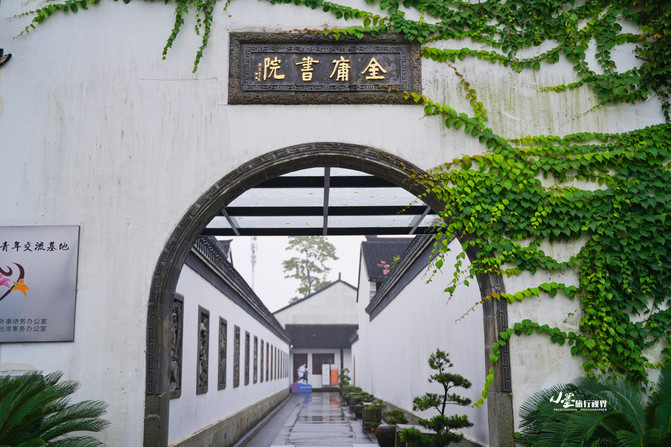
Flying snow shooting white deer in the sky, laughing at the divine hero leaning on the blue mandarin.

How many Chinese people born in the 1970s and 1990s have not read Mr. Jin Yong's novels? Okay, even if you haven't read it, you must have watched TV dramas such as "The Legend of the Condor Heroes", "Heaven Sword and Dragon Saber", "The Legend of the Condor Heroes", "The Legend of the Condor Heroes", "The Legend of the Condor Heroes", "The Legend of the Condor Heroes", "The Legend of the Condor Heroes", "The Legend of the Condor Heroes", "The Legend of the Condor Heroes", "The Legend of the Condor Heroes", "The Legend of the Condor Heroes", "The Legend of?

On March 10, 1924, Jin Yong was born at his home in Yuanhua Town, Haining. He grew up here and also completed primary school there.
In Jin Yong's family at that time, his father, uncle, and brothers were all college students, and the family had a large collection of books. Influenced by his family, he has developed a high level of cultural cultivation since childhood. And the sprout of his martial arts dream in his heart should be the martial arts novel "The Wild River Woman Hero" that he accidentally stumbled upon at home.
This martial arts novel, serialized in the 1930s, opened the way for new literary and artistic writing of martial arts, and also planted the seeds of martial arts in Jin Yong's heart. The Qin and Sword Heroes in the book, with one qin and one sword, intertwined emotions, dragged Jin Yong into a joyful world.
From then on, martial arts novels became inseparable from Mr. Jin Yong.

At the end of 1992, Jin Yong, who had been away from his hometown for more than 50 years, returned to his hometown. He not only visited his alma mater and met his former teachers and friends, but also visited his cousin Xu Zhimo's grave to pay his respects. That's right, the author of "Farewell to Kangqiao", the romantic genius Xu Zhimo, is Jin Yong's cousin of the same clan. emmm, Although their relationship was not good in the past, it can still be attributed to the emotional debt that Xu Zhimo owed back then.

Jin Yong's chronology of works includes fourteen books, including flying snow shooting white deer in the sky and laughing books about the divine hero leaning on the blue mandarin.
As for "The Sword of Yue Women", it was her intention to write one short story each for "The Thirty Three Swordsmen", but only the first one was written, so it is not included in the couplets. However, in terms of martial arts, Ah Qing, the "Yue Nv Sword", is still the strongest.
How strong is it? Three thousand Yue Jia is invincible.


What is the "Thirty Three Swordsmen" painting? It is a famous woodblock painting in ancient China, which includes popular mythological stories such as the old man transforming into an ape and the Three Heroes of the Wind and Dust, as well as night language legends of famous historical figures such as Laozi, Dongfang Shuo, Tao Hongjing, Han Yu, and Lin Bu in the folk.

As for why Mr. Jin Yong only wrote one article, either the original text was too brilliant to rewrite, or it is well-known that there is no need to elaborate. So, there is only one article called "Yue Nv Sword".


These novels have opened the door to a new world for me. It turns out that there are still such bizarre and joyful stories of love and hate in the world.
How many people, when they were young, did not aspire to travel to the world in books, to be a hero or heroine, dressed in white clothes and wielding swords in the martial arts world, witnessing exciting stories and leaving their own names and legends in the world?

Finally, sitting in the tavern, watching the crowd of young people in the martial arts world, I would like to say, "Waiter, serve wine!" How interesting it is.

After reading more books, I still feel that Tai Bai's poetry is the most chivalrous.
Drunk, take off your sword, travel and rest in the high hall to sleep.
At dawn, I brush my sword and head towards the sky. At dusk, I whip my whip and return drunk.
I brought two red feathers to travel between Yan and Zhao. The Sirius is ready to shoot, grateful for the endless leisure. Watching the soldiers on the Hongbo Terrace, leaning on the sword and gazing at the Jade Pass.

The most exhilarating one is still the famous Xiake Xing:
Zhao Ke Man's beard is adorned with tassels, Wu Gou is clear in frost and snow.
The silver saddle shines on the white horse, rustling like a shooting star.
Kill one person in ten steps, leaving no trace for a thousand miles.
After the incident, brush off your clothes and hide deep in your name.
Leisurely passing by Xinling to drink, taking off his sword and kneeling horizontally in front of him.
Roast Zhu Hai and hold a cup to persuade Hou Ying.
Three cups of wine make a promise, but the Five Sacred Mountains are light.
After experiencing eye and ear heat, one's energy and energy will grow.
Saving Zhao with a golden hammer shocked Handan first.
Two brave warriors of the Qianqiu period, renowned in the city of Daliang.
To die with the fragrance of chivalry, not to be ashamed of the world's heroes.
Who can write Your Excellency, White Headed Tai Xuan Jing.

Tsk tsk, the old poem "Xiake Xing" in Yuefu can surpass that of Taibai, perhaps not a single one. Only Li Bai, who has a chivalrous temperament, can write such a chivalrous poem.
In the Tang Dynasty, there was a prevailing trend of chivalry and a disdain for the petty scholars. Apart from the poetry immortal Tai Bai, Wang Han's "grape wine luminous cup" immediately urged him to drink the pipa, while Li He's "man" brought Wu Gou and took over the fifty provinces of Guanshan. Please temporarily ascend to Lingyan Pavilion, like a scholar and a marquis of thousands of households. It is also a rare phrase.

Of course, there is also the Tang Dynasty poet monk Guan Xiu's poem "Full of flowers, three thousand guests drunk, one sword shining cold in fourteen provinces.".

Upon closer reading, you will find that the personal chivalrous spirit of these Tang Dynasty poets is only superficial, embodying the idea of serving the country and pacifying mountains and rivers, perfectly interpreting the theme of "the rise and fall of a country is the responsibility of every individual." However, after the Tang Dynasty, there were very few literary giants with such temperament, such as Su Shi, Lu You, Xin Qiji, Wen Tianxiang, and so on. This is the only hand of the Song Dynasty. Next time there is a chance, let's show off these literary giants again, and we won't waste space here.

Isn't it Jin Yong's former residence? Why do we mention ancient poetry?
What is the central idea of Jin Yong's martial arts and how does Mr. Jin Yong understand the word "xia"?
That's right, the greatest hero is for the country and the people.
Jin Daxia has a great ancient style!

I still remember renting many martial arts novels from the bookstore at the school gate when I was a child. The names of Jin Yong, Gu Long, Liang Yusheng, and Wen Ruian and Huang Yi are also well-known.
Jin Yong's Sage Trilogy, Tian Long Ba Bu, Xiao Ao Jianghu, and Yi Tian Tu Long; Chu Liuxiang, Lu Xiaofeng, Xiao Li Fei Dao, and the peerless Twin Princes of Gu Long; Liang Yusheng's White haired Witch and Seven Swords Down the Tianshan Mountains; Wen Rui'an's Four Great Captains; and Huang Yi's Great Tang Twin Dragons.
They made up half of my childhood.
After so many years, looking at today's online novels, to some extent, they still carry their shadow.
Oh, by the way, there is also the famous science fiction writer Ni Kuang who has written for Jin Yong and Gu Long. Of course, it's for fun. They are close friends and tell a few interesting stories:
Jin Yong's "The Eight Heavenly Dragons" was serialized in the Ming Pao and the Nanyang Business Daily, and was written for about four years. However, the old man stopped writing and went on a long trip to Hong Kong. What should he do? Ni Kuang ghostwriting with a knife. so what? Then Ni Kuang wrote Ah Zi blind.


Also, Gu Long serialized "The Unprecedented Double Pride" for the newspaper, writing that he had to give up halfway when he had something to do. The editor in chief of the newspaper was Ni Kuang, and the newspaper had no choice but to personally take action. I didn't expect this knife catching game to last for half a year, with over 100000 words scattered around. Unfortunately, readers still can't tell whether it's interesting or not.
Of course, there are many ghostwriters for Gu Long (Master Gu Long of Duan Geng), and Jin Yong is just one example.

Mr. Jin Yong used to play Go.
In martial arts novels, having a one-on-one conversation is a standard feature for unparalleled experts.

Mr. Jin Yong's former manuscript, in the era without computers, was written word by word in a serious manner. It's not like now, with over ten thousand words spent all night using intelligent input methods and document correction.

He has also been appointed as an honorary professor and the first dean of the School of Humanities at Zhejiang University for a long time.
"You will always be my little junior brothers and sisters, and I will always be your big senior brother," said the students of Zhejiang University back then.
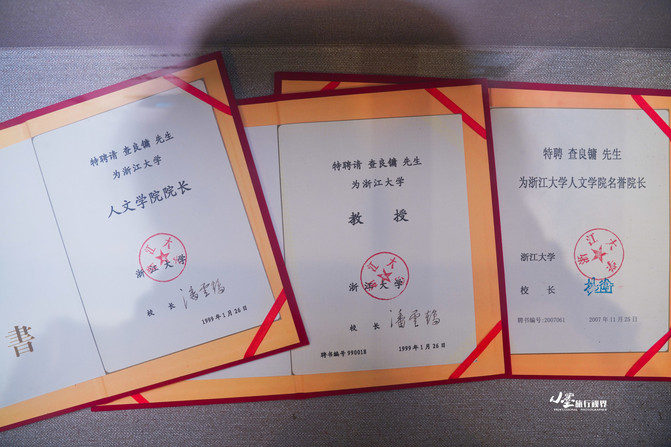
When I was a child, I read martial arts novels and admired the great heroes Jin and Gu. Then one day, I went online and realized that Gu Long had been a Gu before I was born. He passed away in his forties and was sad for a long time.
Last autumn, when I saw Mr. Jin's obituary, I stared at the screen for a long time, unable to explain why.
It's not sad, after all, the old man lived to be 94 years old, just as he looked back on himself: he had good luck throughout his life.
Perhaps it's just for the childhood in my memory.
Cicadas tirelessly sing summer on the trees outside the window, with exciting martial arts movies on the TV, snacks in their mouths, comics in their hands, and unforgettable childhood memories.
Laughing arrogantly in the world has become a masterpiece, and there are no more heroes in the world.
May you go to the world you imagine, become a hero who challenges the world, and realize your concept of "chivalry": the greatest chivalry is for the country and the people.
Goodbye, Great Xia Jin!
Confucius Temple Academy
After Emperor Wu of Han deposed the Hundred Schools of Thought for their exclusive worship of Confucianism, Confucianism has been imprinted in the bloodline of Chinese civilization, passed down and developed from generation to generation, creating a refined, humble, and courteous temperament and literacy of the Chinese nation. As the saying goes, Confucianism is Confucius' Confucianism.

The Confucian Temple is a temple used by feudal dynasties throughout China to worship, honor, and educate Confucius. Since the construction of Confucian temples began in 478 BC, the trend of respecting Confucius during the Tang and Song dynasties has been flourishing. By the Ming and Qing dynasties, the architecture and rituals of Confucian temples had become customized, and Confucian temples had become the most culturally distinctive sacrificial architectural system on the land of China. They were the most rigorous and majestic ancient architectural community besides royal architecture, and also the imperial palace of ancient China's spiritual world.


As the name suggests, the academy is the hall of learning. In ancient times, the academy was a place where great scholars taught and students studied, similar to today's schools. Of course, the things they learn vary greatly. In ancient times, there was no emphasis on mathematics, physics, chemistry, or the middle and high school entrance examinations. Their promotion system was based on the imperial examination.

A dazzling array of prayer symbols, the Confucian Temple School Palace is a great place to pray for academic and career blessings.

The talent selection system in China has gone through thousands of years of development, from the pre Qin system of imperial officials and military achievements, to the Han Dynasty's system of imperial examinations, and then to the nine rank system of the Wei, Jin, Southern and Northern Dynasties. After Emperor Wen of Sui unified the whole country, in order to strengthen centralization, the power to select officials was transferred to the central government, and the ninth rank system of the imperial examination system, which was characterized by the absence of noble families and noble families, was abolished. The imperial examination system took to the historical stage. After the improvement of Emperor Taizong of Tang, Empress Wu Zetian, and Emperor Xuanzong of Tang, the imperial examination system was officially established.

The imperial examination system began in the Sui Dynasty, flourished in the Tang Dynasty, declined in the Ming and Qing Dynasties, and lasted until the emergence of modern school education in 1905. From the third year of the Sui Dynasty's Daye era (607 AD) to the 31st year of the Qing Dynasty's Guangxu era (1905 AD), it took more than 1300 years.
Oh by the way, during the reign of Empress Wu Zetian, she also pioneered the martial arts examination.


During these 1300 years, the imperial examination system prevailed and became a ladder for scholars from humble backgrounds to ascend to heaven. The Confucian Temple School in Haining, following the regulations of the Song Dynasty's Left School and Right Temple, was a local official school of various dynasties, with a special status and deep roots.


Due to the prominent position of Confucianism in the process of Chinese civilization, the imperial examination has also become a necessary path for students to change their destiny and achieve their ideals and aspirations. As a result, the Confucian Temple and Palace enjoy a special status and are regarded as the sacred hall of Chinese culture.


During the Ming and Qing dynasties, academic palaces were established in various prefectures and county offices. The architecture of the Haining Confucian Temple School is grand and magnificent, not only adhering to the traditional architectural style of Chinese Confucian temples, but also with distinct local characteristics, combined with local folk customs, presenting the cultural and cultural heritage of the Jiangnan region.
The current Haining School Palace is surrounded by representative landscape buildings such as the national cultural heritage unit Haishen Temple and Jinyong Academy, as well as the best viewing spot for first-line tides in the scenic spot park. The scenic spots are concentrated and magnificent, making it an important highlight of the tourism culture of the ancient city of Yanguan.

Tanah Lot
The term "Haining" first appeared in the second year of Yongding reign of Emperor Chen Wu of the Southern Dynasty (558 AD), symbolizing "peaceful sea floods".
For the people who relied on the sea to make a living in ancient times, the joys and sorrows of the sea were related to their livelihoods and even their lives, and "Haining" embodies the beautiful expectations of coastal people for a peaceful life.


In ancient times, when people were more ignorant and superstitious, the best objects and places to pray for blessings were certainly gods and temples, and the Sea God Temple emerged.
In the land of Zhejiang, the most famous Sea God Temple is located in Yanguan Ancient Town, Haining City, Jiaxing, Zhejiang, which is the magnificent temple in front of us.

This Sea God Temple, also known as the "Temple Palace" in the local area, is magnificent and spectacular.
In modern times, Haining is famous throughout the world for the Haining Tide, but in ancient times with low productivity, the Haining Tide was a terrifying natural disaster that plagued the local people. According to local chronicles, the tide situation in Haining worsened after the Song and Yuan dynasties. By the Yongzheng period of the Qing dynasty, the tide disaster in Haining was rampant, and the banks of the ponds were repeatedly breached, turning a thousand miles of fertile land into a vast expanse of land, causing great disturbance to the people.
Emperor Yongzheng dispatched several high-ranking officials, local governors, and governors to Haining to oversee the construction of the pond and repair it urgently. During the 13 years of Emperor Yongzheng's reign, he constructed the Haining Pond 18 times, which consumed a huge amount of manpower and financial resources. He also established the annual repair system for the Haining Pond in western Zhejiang for future generations.


The Sea God Temple was also built during this period. In March of the eighth year of the Yongzheng reign of the Qing Dynasty (1730), the Governor General of Zhejiang, Li Wei, was ordered to build the Sea God Temple. A 40 acre plot of land was opened inside the Chunxi Gate (now No. 150 Chunxi Road, Yanguan Town). In November of the following year, this temple dedicated to the God of Zhejiang Sea was built to worship the God of Yunde and the Tide of the Sea.


When the Sea God Temple was first built, the main hall was dedicated to the main deity, King Wu Su Qian Liu, and Duke Wu Zixu of Wu Yingwei. This hall is built in the form of Taihe Hall in the Forbidden City of Beijing. The emperor has seven steps in four directions. The colonnades, steps and stone railings are all carved with White Marble. The stone railings are also carved with dragon, tiger, flower, bird, cloud and water patterns.
Such a beautiful and magnificent White Marble ancient palace can't be found in Zhejiang.
As time goes by, the natural disasters of the past have already turned into spectacular scenery. The towering Sea God Temple still stands quietly at the mouth of the Qiantang River, telling ancient stories in the wind.

Haining Sculpture Park
On the other side of the mountain and the sea, there is a sculpture park.
In the past two years in Haining, a new Chaoqi East Sculpture Park was opened. At that time, a Chaoqi East China Haining Qiantang International Sculpture Exhibition was also held, attracting many domestic and international sculpture masters to participate. Dozens of exquisite sculptures were spectacular.

The stunning trend of WodrefulTide, Filin Gueorgui, Italy, showcased a silver medal. The work is made of noble marble material, which condenses the shocking psychology of humans watching huge waves and tides in the form of abstract sculpture in space. The free combination of irregular circular holes and dots not only symbolizes the tide and waves, but also implies the symbiotic coexistence between humans and the tide, demonstrating the eternal relationship between humans and the tides of the river and sea.
WodrefulTide Italian Filin Gueorgui:

The green grass is leaning against the blue sky and white clouds. Nowadays, the Oriental Sculpture Park has become a good place for Haining people to relax and visit.
The Chaoqi East Sculpture Park is located at the easternmost section of the Baili Qiantang Green Belt in the Haining Yanguan Tide Viewing Tourist Resort, on the east side of the Qiantang Grand Gap Tide Viewing Point.
When the tide rises and the moon is full, Zhu Chen:

"The Sound of the Sea" by Shen Jianguo:

Jin Guanchao, Bai Yu, Dong Mingguang, Silver Award. The creative concept of the work comes from ancient Chinese jade. Showcased the Eastern philosophy of representing the universe through a circular ring. The square skeleton and stainless steel patch, with the interplay of reality and virtuality in the rich circular ring, demonstrate the grand atmosphere of all things coexisting, small in size, big in size, and repeated and unified renewal.
"Jin Guan Chao" by Bai Yu and Dong Mingguang:

Surrounded by greenery, the sculpture is coated with a golden glow by sunlight, emitting a strong artistic atmosphere.
"High Mountains and Flowing Water" by Chen Hui:

"Mingyue Chaosheng" by Men Yaxu:

"Making Waves" by Yan Kun:
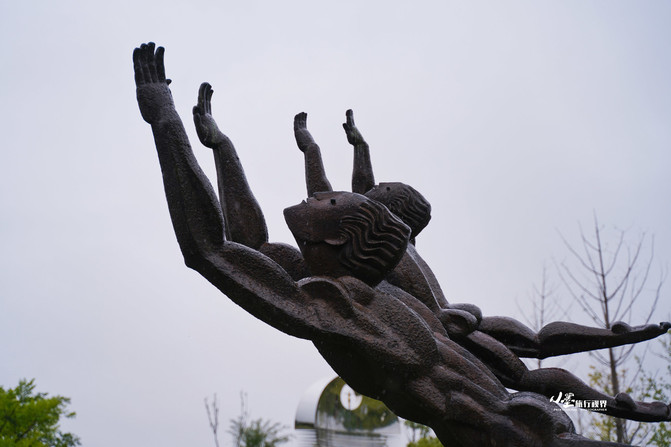
Thirty seven sculptures in the park are all made by domestic and foreign sculpture masters. Rich in content, diverse in materials, and well crafted, it fully embodies the profound historical and cultural, natural landscape, and contemporary artistic concepts of Haining, showcasing the era style of Haining people welcoming, chasing, and playing with the tide, becoming another new tourist landmark along the Qiantang River.
"The Island of Life" by Zhu Shangxi:

Fangcao Qingqing RV Campsite
Body and soul, there is always one on the road.
Why bother so much, traveling can allow your body and soul to reach the distance at the same time.
Unfortunately, following a group tour is too inconvenient, and traveling freely is too tiring. How can one have both freedom and comfort?
Simple, just one RV is enough.

With the popularity of RVs in Europe and America, this novel way of traveling has become increasingly popular in China.
Escaping the city and embracing freedom, even a short vacation can be satisfying.

RVs are mobile homes, but they also require a parking spot, which is why RV campsites have emerged.
If it can only meet daily supplies, it is nothing more than a gas station. If leisure and entertainment are added, it can be considered a campsite.


In the past two years, Kaiyuan has added a new member - Fangcao Qingqing RV Campsite. The first one is located in the ancient city of Yanguan and the ecological green belt of Qiantang, a hundred miles away.
"Wonderland RV Camp", also known as "lush green grass", is derived from the Spanish word "Cincin", meaning to clink glasses during gatherings.

Self catering, outdoor barbecue, chess and card entertainment, sports and leisure, children's play, strolling in the blue sky and green grass, embracing the long lost freedom.
If you get tired of sleeping in a motorhome during a long trip, you can also stay here for a few more days, camping in tents, fishing for leisure, picking fruits in the orchard, and expanding into the wild, enjoying a creative life journey in nature.

Chinese cuisine in Yanguan Ancient Town
By noon, we had a big feast in the ancient town of Yanguan, eating and drinking enough before we could become a trendsetter in the afternoon Qiantang tide.
The smooth and fragrant shrimp and eggs are completely different from those eaten elsewhere.

Eye cake is a special snack in Haining. Because Rice noodles is white like a human face and the stuffing is black like eyes, local people call this kind of cake eye cake. It is said that the popularity of glasses cake was promoted by Li Wei, the governor of the Sea God Temple, as mentioned earlier, to reward the workers who repaired the embankment.

Cowpea Mantou is sweet.
Watching the Chaos in the Scenic Area Park
The highlight should be put to the end, the protagonist always makes the final appearance.
Coming to Haining, the protagonist is naturally the world-renowned Qiantang Tide.
It should be a Chinese language book for the second year of junior high school. I forgot whether it was from the previous semester or the next semester. There is a classical Chinese article called "Observing the Tide", which starts with a grand momentum:
The tide of Zhejiang is the magnificent view of the world. From now on until the 18th, it will be prosperous. Fang Qiyuan's departure from the sea gate is like a silver line; As it approached, the Yucheng Snow Ridge came from the sky, loud like thunder, shockingly shooting, swallowing the sky and fertile sun, with an extremely powerful momentum. Yang Chengzhai's poem goes, "The surging silver is a Guo, and the jade in the river is tied to the waist.".


The first half of the article provides a detailed description of the magnificent Qiantang Tide, while the second half depicts the heroic demeanor of the navy in reviewing and riding the tide.
I still remember the expectation of the Chinese teacher at that time: I hope you can all stand at the forefront of the tide and become the trendsetters of the times.
The scene at that time and this word deeply engraved in my mind. At that time, I longed for the day when I could go to the mouth of Qiantang and see the Qiantang tide with my own eyes.


Unexpectedly, as time passed, I gradually forgot about this wish. It wasn't until early autumn this year that I saw on local news that the Qiantang River was about to surge.
So there was this trip.

The best scenic spot for observing the Qiantang River tide is the Tide Viewing Resort Park located in the south of Yanguan Town, which is the best location to observe the Qiantang River tide.
The Qiantang Tide surges to this location with the highest tide force, and it is characterized by a line alignment, hence it is known as the Haining Pagoda Line Tide. "Su Lian Hengjiang, the long flat sand rises with a white rainbow" and "Wanting to know how high the tide is, crossing the mountains and crossing the waves" are the true portrayal of it.

A city story, a river tide. Haining Yanguan Town is the first popular spot for observing the tides in Qiantang, so there is also a unique name for Qiantang Tide: Haining Tide.
Throughout history, there are three most famous tidal bore areas in China: Qingzhou tidal bore in Shandong, Guangling tidal bore, and Qiantang tidal bore.
Not many people have heard of Qingzhou Tide, after all, it was during the Spring and Autumn period and the Warring States period, so there were probably not many who had the leisure to watch the tide. Guanglingtao is somewhat famous, but of course, it has little to do with Ji Kang's "Guanglingsan". It is a qin piece, which Nie Zheng used to stab Han Gui.
I digress from the topic. The appearance of Guangling Tao was slightly earlier than the Qiantang Tide, and the specific time cannot be verified. It is estimated that one was during the Western Han Dynasty and the other was during the Eastern Han Dynasty.

In the eyes of ancient people at that time, it was still necessary to go to Guangling to watch the tide, a phenomenon that lasted from the Han Dynasty to the Six Dynasties. Which Six Dynasties? Wu, Jin, Song, Qi, Liang, Chen.
During the Tang and Song dynasties, the center of literati's observation of tides gradually migrated from Guangling to Qiantang, which was probably related to geographical environment and climate change. From historical records, it can be seen that in the Qing dynasty's "Guangling Tao Bian" (1664), it was recorded that during the Spring and Autumn period, tides flourished in Shandong, and during the Han and Six Dynasties, they flourished in Guangling. After the Tang and Song dynasties, the tide flourished in Zhejiang, covering the earth from north to south, and there were those who truly understood its nature.
In addition, the great philosopher of the Eastern Han Dynasty, Wang Chong, also recorded in "Lunheng" that "there are waves in Zhejiang, Shanyin River, and Shangyu River.". It is also said that at that time, Qiantang in Zhejiang; All the temples of Zixu are erected, with the intention of comforting their hatred and stopping their fierce waves;.

Why use a statue of Wu Zixu? In folklore, Wu Zixu is a symbol of the Tao God. Here is also related to the origin of a festival, that is, the Dragon Boat Festival of eating Zongzi and racing Loong Boat. There have been several theories circulating about the origin of the Dragon Boat Festival, among which the earliest one was not Qu Yuan, but Wu Zixu, the high-ranking official of the state of Wu who died overnight.


Not wasting space to elaborate on the life of Wu Zixu, after all, there were too many legendary stories in his life. He faithfully helped the King of Wu break through the strong Chu in the west, wield the power of Qi and Jin in the north, and subdue the people of Yue in the south, helping the state of Wu reach its peak. Unfortunately, his supernatural powers were no match for fate, and Wu Zixu, who was talented and strategic, ultimately died at the hands of the stubborn and self righteous King Fuchai of Wu, solely due to the slander of petty people.
At the end of the story, Wu Zixu committed suicide and was sunk to Qiantang. The proud and arrogant King Fuchai of Wu and the brave King Goujian of Yue finally took control. After Fu Chai committed suicide by covering his face, the people of Wu increasingly missed Wu Zixu, the pillar of the country. For thousands of years, it has been said in Jiangsu and Zhejiang provinces that Wu Zixu's loyal soul was transformed into Tao God after his death. Loong Boat Festival is the day to commemorate Wu Zixu.
Furthermore, I believe that regarding the origin of the Dragon Boat Festival, compared to Qu Yuan in the late Warring States period, it was still earlier than Wu Zixu in the Spring and Autumn period.

Rapidly advancing, this is a gift written by Mr. Sun Yat sen for Haining County B-type Business Vocational School. It means galloping forward like the tide of the Qianjiang River.


This is a southeast shaped scenic spot, surrounded by the Zixu Temple.
I don't know how many hero tears, turned into a thousand year angry wave.
Thunder drums startle the strange insects in the distant river, and snow carts drive horizontally across the sea gate.
Wu Er's destiny is as light as a leaf, competing for the tide with a strong spirit.

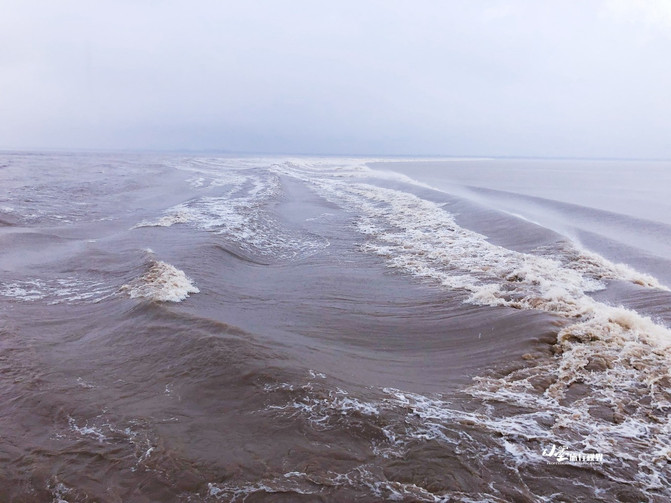
Looking at history and the present, and looking at the world horizontally, the Qiantang Tide is one of the three major tides in the world. These three tides are the Ganges Tide in India, the Amazon Tide in Brazil, and the Qiantang Tide in China.
Perhaps the weather is not very beautiful, and today's Qiantang tide is not as surging and surging as before. I didn't see Mr. Dongpo's "August 18th tide, spectacular and unparalleled in the world", and indeed it came early.
The best season for observing the tides should be around three days on the 18th day of the eighth lunar month. In ancient times, the troops stationed in Zhejiang would inspect the navy on the Qiantang River on the 18th day of the eighth lunar month. Later, it became known as the "Qianjiang Autumn Waves", which became famous throughout the world.

It's also because I didn't finish my homework well, so I came to watch the trend with just a slap on my forehead.
Let's wait until after the Dragon Boat Festival and let the momentum of the Qiantang tide accumulate again. On August 18th, let's enjoy the magnificent spectacle of "the towering waves emptying, overturning the river and destroying the sea and mountains".

Finally, there are two timetables for watching the tide. Don't miss them, if you miss this one, you will have to wait for another year.

Previous Article:Hiking in the water from above, during the busy days in Jiaxing
Next Article:Three days and two nights, playing Huayi Brothers Film World and Xitang Ancient Town
